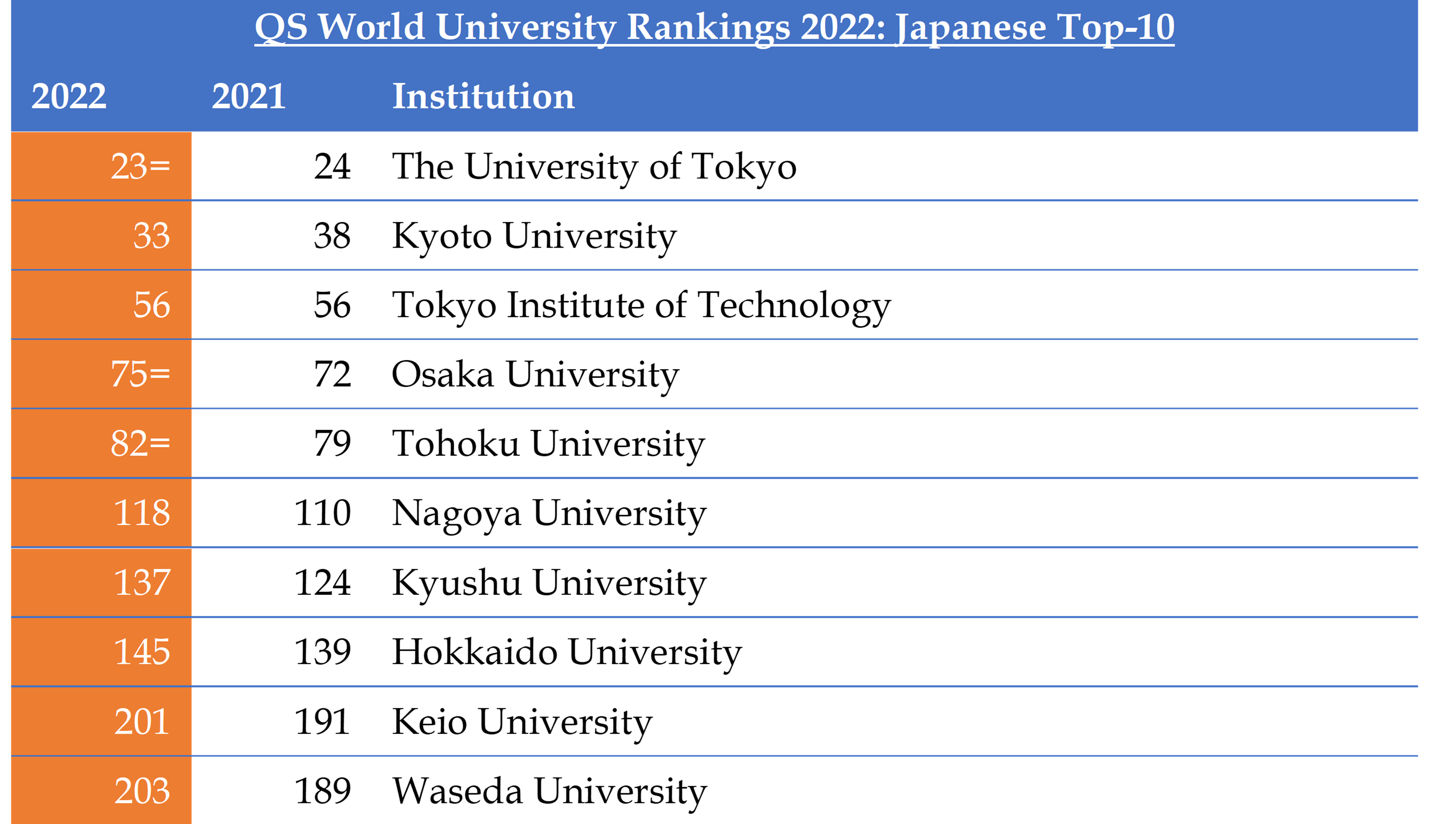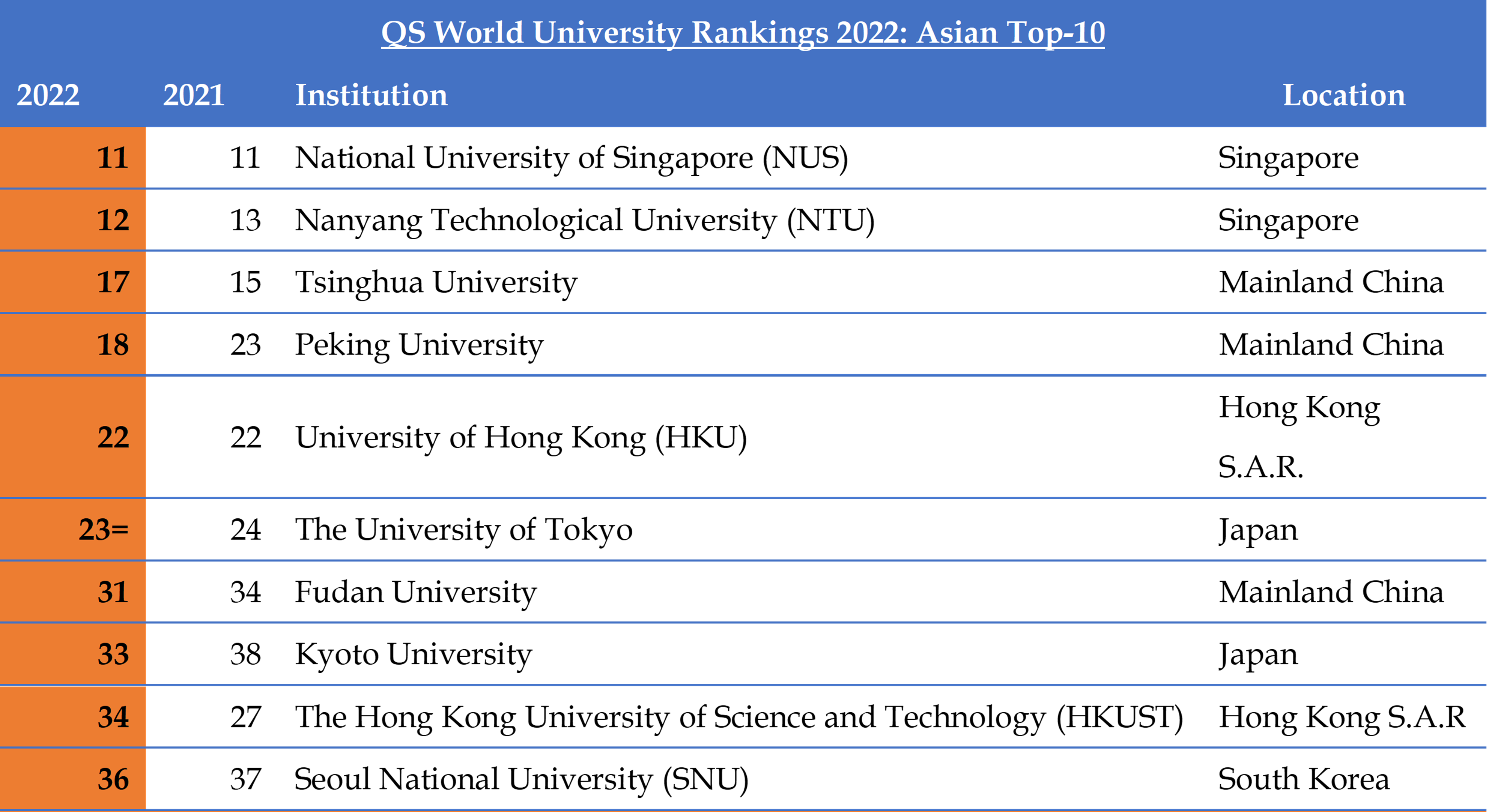Jun 09.2021
The QS World University Rankings 2022 has just been released by QS, a global university grading organization with which KEI Advanced has a business partnership. It ranked the top 1,300 universities in 97 locations around the world.
QS World University Rankings 2022
48% of Japanese universities fall in latest global rankings
London, 9th June 2021: QS Quacquarelli Symonds, global higher education analysts, has today released the eighteenth edition of the world's most-consulted international university rankings. The results see nearly half of Japan's ranked universities decline in rank, relative to last year's position. Despite these drops, the University of Tokyo rises one place to joint 23rd globally, and sixth in Asia. Only once in the last ten years (2020, 22nd) has it placed higher.
Massachusetts Institute of Technology achieves a record-extending tenth consecutive year as world number-one. The University of Oxford has risen to 2nd for the first time since 2006, while Stanford University and the University of Cambridge share 3rd spot.
QS include 48 Japanese universities in the published table, seven more than in last year's edition. Of these 48:
-
-
- 23 have declined in rank (47.9%)
- 5 have risen in rank (10.4%)
- 17 have neither risen nor declined in rank (35.4%)
- 3 are new inclusions in this exercise.
-
QS's data indicates that The University of Tokyo continues to excel across the majority of indicators used to compile the ranking. For example:
-
-
- It achieves a perfect score (100/100) for QS's Academic Reputation indicator, demonstrating outstanding regard among the international academic community.
- It achieves a near-perfect score (99.6/100) for Employer Reputation and has improved its standing among employers over the past year.
- It has risen to 70th in the world for QS's measure of teaching capacity, Faculty/Student Ratio (FSR), with a score of 92.4/100.
- It achieves a score of 79.0/100 for QS's measure of research impact, Citations per Faculty, and has improved its research impact performance over the last year.
-
Other noteworthy results for Japanese institutions include:
-
-
- Kyoto University (33rd) has risen five places year-on-year - it has not ranked more highly since 2011.
- Tokyo Institute of Technology (56th, no change) remains in its highest rank since 2009's edition of the tables.
- Osaka University has fallen to joint-75th. This is its second-lowest position in the history of the rankings. Only in 2005 (105th) has it ranked lower.
- Keio University (201st, down ten places) has fallen out of the top 200 for only the fourth time in fifteen appearances in the tables.
- Waseda University (203rd) loses the top-200 place it regained in 2019's edition of the tables.
- Tokyo Medical and Dental University excels for Faculty/Student Ratio, achieving a perfect score of 100/100. It is one of nine Japanese universities to achieve a top-100 score for Faculty/Student Ratio.
-
Ben Sowter, Director of Research at QS, said: "As Japanese universities continue to struggle in the QS World University Rankings, it is crucial to understand the reasons behind these regressive trends. The underlying data implies that the global academic community still - generally - holds Japanese universities in high esteem. The major trend contributing to Japanese falls is declining research performance, which is the result of two decades of under-investment in the country's intellectual capital - the number of PhD students in Japan is almost half its 2003 total. One could draw a sharp distinction between Japan and China, the latter of which has been relentlessly increasing its number of doctorates; or Switzerland, which offers highly generous funding to PhD students. The new Japanese Innovation Fund, announced at the start of the year, is a promising step towards resurrecting Japan's waning research footprint, but, with investment still not due to begin until 2022, it will take years before the results are visible in our rankings."
This year, QS will list the world's top 1300 universities - 145 more than in last year's edition - which can be found in 97 locations. 6415 institutions were eligible for the survey analysis, and 1705 were assessed for the final table. The results will account for the distribution and performance of 14.7 million academic papers published between 2015 and 2019, and the 96 million citations received by those papers; they also account for the expert opinions of over 130,000 academic faculty and over 75,000 employers.

© QS Quacquarelli Symonds 2004-2021 https://www.TopUniversities.com/. All rights reserved.

© QS Quacquarelli Symonds 2004-2021 https://www.TopUniversities.com/. All rights reserved.
Methodology
QS use six indicators to compile the ranking:
-
-
- Academic Reputation: based on survey responses from over 130,000 academics.
- Employer Reputation: based on survey responses from over 75,000 employers about the relationship between institution and graduate employability.
- Citations per Faculty: measuring research impact, it divides the total number of citations received by a university's research papers over a five-year period by the number of faculty at an institution.
- Faculty/Student Ratio: a proxy for teaching capacity. Student numbers are divided by faculty numbers, giving the global student body some indication of likely class sizes at their selected institution.
- International Faculty Ratio: one of QS's two measures of internationalization, it measures the proportion of non-domestic faculty at an institution.
- International Student Ratio: the second of QS's two measures of internationalization, it measures the proportion of non-domestic students at an institution. This, in turn, provides an indication of a university's ability to attract talent from across the world.
-
Further methodological information can be found at https://www.topuniversities.com/qs-world-university-rankings/methodology.
The full rankings can be found at www.TopUniversities.com from Wednesday 9th June, 05:00 JST.
-Ends-
For interviews with QS's analysts, please contact:
Simona Bizzozero
Director of Communications
QS Quacquarelli Symonds
simona@qs.com
pressoffice@qs.com
@QS_pressoffice
+ 44(0)7880620856
+44 (0) 2072847248
Jack N. Moran
Senior Public Relations Manager
QS Quacquarelli Symonds
jack@qs.com
@JackNathanMoran
+44 7474 847 430
Notes for Editors
QS Quacquarelli Symonds
QS Quacquarelli Symonds is the world's leading provider of services, analytics, and insight to the global higher education sector, whose mission is to enable motivated people anywhere in the world to fulfil their potential through educational achievement, international mobility, and career development.
The QS World University Rankings portfolio, inaugurated in 2004, has grown to become the world's most popular source of comparative data about university performance. Their flagship website, www.TopUniversities.com - the home of their rankings - was viewed 147 million times in 2020, and over 79,000 media clippings pertaining to, or mentioning, QS were published by media outlets across the world in 2020.
About Scopus info.scopus.com
Scopus is the largest abstract and citation database of peer-reviewed literature and features tools to track, analyze and visualize scholarly research. Its comprehensive database contains 55+ million items indexed from 21,000 titles from more than 5,000 publishers worldwide, ensuring broad interdisciplinary coverage in the fields of science, technology, medicine, social sciences and arts and humanities. Scopus was designed and developed with input from researchers and librarians and features direct links to subscribed full-text articles, other library resources and interoperability with applications such as reference management software. Scopus is part of the Elsevier Research Intelligence portfolio which includes the SciVal tools, the Pure system, rich data assets and custom Analytical Services.
